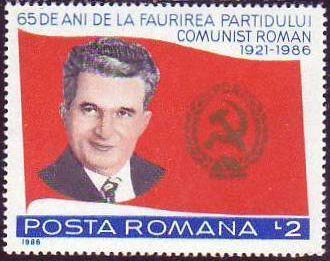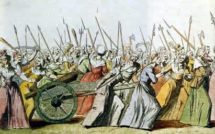

This is part of our special feature, Imagining, Thinking, and Teaching Europe.
This paper comes from a Postwar Europe class I taught in the fall of 2019 at the University of New Orleans. The assignment asked students to use The Story Smuggler―Georgi Gospodinov’s experimental memoir about his youth in communist Bulgaria and the impact those experiences continue to exercise on his life today as a writer and intellectual―as a lens through which to read another Eastern European society’s experiences with communism in the 1980s. In a standout submission, Kevin Michot chose to read the downfall of Nicolae Ceausescu’s regime in neighboring Romania through Gospodinov.
For more on this assignment and its successes and failures, see “Georgi Gospodinov’s The Story Smuggler: Teaching Europe through Contemporary Experimental Literature” in the June issue of EuropeNow.
—Nicholas Ostrum
By the late 1980’s, the postwar generations of Romania, no longer willing to accept an oppressive Communist regime, fought for and achieved their freedom. Although few could have predicted how quickly the system would collapse, the seeds of these rebellions, like in the rest of Eastern Europe, had sprouted decades earlier. The failed policies of Romania’s Communist dictatorship—including economic stagnation, low standards of living, and a harsh crackdown on Western influence and media—led Romanians, especially the youth, to join the rest of Eastern Europe to reject Soviet influence in their country.
In his memoir The Story Smuggler, Georgi Gospodinov describes his childhood in Bulgaria under Communism as “love in the time of cholera;” it created the need for something new and acknowledged the impossibility of change.[1]Gospodinov compensated for this discrepancy by living through his dreams of decadent cake and gold, likely what children in Romania and all other countries in the Eastern bloc did as well.[2] As with Gospodinov’s Bulgaria and other Eastern contemporaries, Romania’s journey from Communism to democracy capitalized on these dreams in conjunction with the woes of reality to inspire the youth to rise up for freedom.
Unlike most countries in the Eastern bloc, Romania charted its own course somewhat independently of the Soviet Union due to the leadership of Gheorghe Gheorghiu-Dej and Nicolae Ceausescu. Following Albania’s shift towards China and the independence of Yugoslavia, the Soviet Union could not afford a similar incident in Romania because that would have further weakened Soviet dominance in the Balkans.[3] As a result, the Stalinist Gheorghiu-Dej gained some breathing room for his country, especially after his public support of the 1956 Soviet military intervention in Hungary.[4] Among his priorities, Dej promoted industrialization for the country, although the Soviets preferred Romania to remain agrarian.[5] By the time of his death, Romania’s quasi-independence had barely begun, leaving much room for his successor Ceausescu to expand upon. Ceausescu gained power in the late 1960’s as President of the Communist Party; in 1974, he became President of Romania.[6]
Ceausescu formed his own political philosophy, known as “national communism,” or “nationalism within a communist framework.”[7] By “cultivating national pride” and because of early economic growth and “sufficient supplies of foodstuffs and other necessities,” according to Ian Kershaw, Ceausescu enjoyed a period of popularity among the people.[8] As part of this “national communism,” Ceausescu also allowed some access to Western media during his early years as leader, although by 1971, he had curtailed these freedoms and increased censorship on media outlets.[9] These restrictions helped sour the youth’s perception of the Romanian government and Ceausescu in particular.
Imagine the youth of Romania in the late 1960’s, who never had much to begin with, observing these media for the first time, completely mesmerized by Western ideas, images, and art forms, to which they had never had access before. Now imagine their disappointment when the government suddenly took away this freedom that not only had allowed them access to new ideas and philosophies, but had also given them a window into the prosperity and ingenuity of the West.
These children had not lived during World War II or the prewar years. They had never known life could be anything outside of Communism and dictatorship. Their minds should have become the perfect vessel for communist propaganda, as they had no memories of prewar life to draw upon. Ideally, the leadership would use these new generations across the Eastern countries to carry their messages into the future and ensure their regimes remained everlasting. Yet, across the East, these children would become those who, two decades later, led the call for change. In Romania especially, these people had not forgotten their brief glimpse into life in the West when they were younger.
Although Western trends and music were taboo under Communism, the youth of Eastern Europe still had access to them.[10] Gospodinov attests that homemade lexicons allowed the children to exchange ideas and discuss their favorite bands, clothes, art, and advertisements under the noses of disapproving teachers and government officials.[11] In these lexicons, the students could compile lists of new Western words they learned from their friends and pass them on to others, thereby forming new friendships and groups to discuss their ever changing philosophies on what should become acceptable in their world.[12] Everything from music to movies to the concept of love brought new ideas and longings to the children of the East.
Perhaps an opportunity could have arisen for these longings to become reality in Romania had Ceausescu continued his flirtation with Western media. But just as Ceausescu ended the use of Western media in Romania, the dream of wanting more also ran into the brick wall of Communism. If the status quo endured, these dreams would remain unrealized. Most people, however, did not make this connection right away. After all, in the 1960’s, the Romanian economy, partly based on oil, was in fairly good shape, which made it easier for people to believe in Ceausescu’s propaganda. People started thinking that perhaps the status quo was irreproachable and that Ceausescu actually did know best. Yet, in the next decade, events would reshape Romania and erase Ceausescu’s ace in the hole.
The relatively stable economic conditions that gave Ceausescu his early popularity would quickly evaporate in the 1970’s, leaving his political faults bare for all to see. Romania’s domestic oil supply managed to shield the nation from some of the worst effects of the 1973 oil crisis; however, Romania still did not have enough to keep the economy healthy.[13] In fact, the increased global demand forced Romania to import large amounts of oil, which led to skyrocketing debt levels and brought the Romanian economy to a standstill throughout the 1970s and 1980s.[14] Referring to Eastern Europe in general, Kershaw writes that “by the end of the 1970’s, growth had slowed drastically or turned negative across the region.”[15] Ceausescu did have a plan for restoring economic growth, but his shortsightedness would ultimately lead to his demise.
Throughout the early 1980’s, Ceausescu attempted to curtail the national debt and restore economic security to the country. He pledged to completely pay the debt back after the International Monetary Fund rescheduled certain payments.[16] To accomplish this goal, Ceausescu imposed “horrendously draconian cuts” in consumer spending―including a “rational eating programme”―reduced importation of essential food items, and restricted electricity consumption.[17]Yet, he seemed to sacrifice nothing in his own lifestyle.[18] As a result, many began doubting Ceausescu’s authoritarian leadership, as he came to appear, as Kershaw describes, a “latter day Nero luxuriating in a lifestyle of brazen extravagance and relishing a personality cult that plumbed the depths of servility and absurdity.”[19] The dictator lost much of his earlier support, particularly among the youth who were coming of age in this time of economic stagnation. Those same children who remembered their brief interactions with Western media, their lexicons, and their secret meetings had become adults during one of the most unstable times in Romanian history. This is when they decided to act.
The younger generations had never known life before Communism, but they could see the prosperity just over the Iron Curtain. They, like Gospodinov, could not understand why the West appeared so prosperous while their government repeatedly told them of the evils and excesses of the West. Teachers taught the children of the East that the sun rises from their land and from the Soviet Union.[20] They also instilled upon the schoolchildren that “sunset was patently a Western phenomenon, and nothing good could ever come from the West.”[21] If this were the case, then why did the West appear so much better off?
The year 1985 saw Mikhail Gorbachev become leader of the Soviet Union and, with him, major reforms swept throughout the Eastern bloc. Perestroika and glasnost rippled throughout the region, but since Ceausescu chose to distance himself from Soviet influence, he succeeded in prolonging his authoritarian regime for a time.[22] Because of this discrepancy, Romanians could look to the East as well as the West to see what benefits reforming the system could bring them. This only served to isolate society further from Ceausescu’s antiquated ideas of government. Unlike in the rest of the Eastern bloc, it took a bloody revolution to topple Ceausescu’s Communist regime. Ceausescu met his end after the army and the young revolutionaries desperate for change arrested the dictator and executed him on Christmas Day 1989.[23] His death, however, did not automatically usher in a new era of democracy and prosperity. Romania required a long adjustment period to form a new constitution, grow the economy through privatization, and remove the remaining former Communists from the government.[24] But the people, at least, could have their cake, just as Gospodinov dreamed.
Kevin Michot is a recent Summa Cum Laude graduate of the University of New Orleans with a bachelor’s degree in History and a Minor in Music. He is also a former member of the university’s History Club (Phi Alpha Theta). Raised in the greater New Orleans area, he achieved the rank of Eagle Scout in 2015 and graduated from Ridgewood Preparatory School in Metairie, Louisiana in 2016 as Valedictorian. He will be attending Loyola University New Orleans School of Law in the fall of 2020.
Nicholas Ostrum received his Ph.D. in History from Stony Brook University in 2017. He is currently an instructor at the University of New Orleans and Clark State Community College and has been a member of EuropeNow’s Research Editorial Committee since the journal’s inception.
References:
[1] Gospodinov, Georgi, The Story Smuggler, trans. Kristina Kovacheva and Dan Gunn (London: Sylph Editions, 2016), 10.
[2] Gospodinov, Story Smuggler, 10.
[3] Kershaw, The Global Age, 252.
[4] Ibid, 107.
[5] Ibid.
[6] Kershaw, The Global Age: Europe 1950-2017, (Great Britain: Penguin Random House, 2018), 252.
[7] Ibid, 252.
[8] Ibid.
[9] Ibid.
[10] Gospodinov, Story Smuggler, 12.
[11] Ibid, 13.
[12] Ibid, 13.
[13] Kershaw, The Global Age, 268.
[14] Ibid.
[15] Ibid.
[16] Ibid, 324.
[17] Ibid.
[18] Ibid, 325.
[19] Ibid, 326.
[20] Gospodinov, Story Smuggler, 12.
[21] Ibid.
[22] Kershaw, The Global Age, 327.
[23] Ibid, 367.
[24] Ibid, 368.
Published on June 3, 2020.




